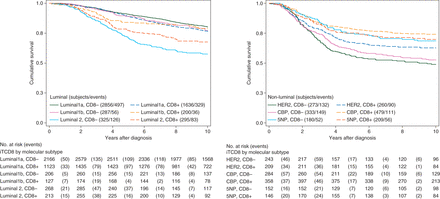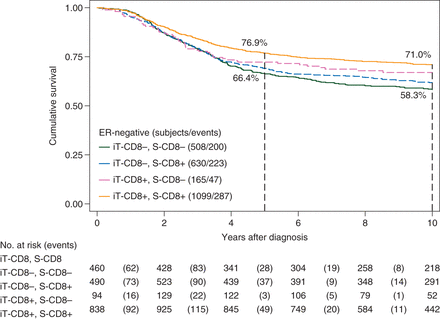7 september 2014: Bron: Ann Oncol. 2014;25(8):1536-1543.
Aanwezigheid van CD8 positieve expressie plus T-cellen in de tumor en beenmerg wijzen op een significant verlaagd risico op overlijden aan borstkanker. Percentages van 21% tot soms 57% minder risico op overlijden zijn gevonden, afhankelijk van de plaats van de tumoren. Dit gaat op voor zowel oestrogeen positieve vormen van borstkanker met HER2-positieve receptor (ER-positief) als voor borstkanker met ER-negatieve vormen van borstkanker.
Dit blijkt uit een grote meta analyse van 4 gerandomiseerde studies bij totaal 12.439 patiënten met borstkanker. CD8 expressie en T-cellen zijn vantevoren te meten. Bv. via een biomoleculair profile onderzoek.
Het mooie van deze studie is dat CD8 positieve expressie als T-cel infiltratie blijkbaar geen onderscheid maakt tussen welke vorm van borstkanker wat betreft hormoonstatus (ER-pos of ER-neg) enz.. De onderzoekers stellen zelfs dat borstkanker blijkbaar een meervoudige moleculair gerelateerde ziekte is en geen enkele ziekte op zichzelf.

Deze studie van 12 439 vrouwen met borstkanker is de grootste evaluatie van T-cellen als een tumor marker in data van patiënten met borstkanker.
Hieruit blijkt dat de aanwezigheid van CD8 + T-cellen in ER-negatieve borsttumoren is geassocieerd met een vermindering van het relatieve risico op sterven aan borstkanker tussen de 57% en 21% afhankelijk van hun locatie (iT, Stroma of beide) en voor iT-CD8 + T-cellen vonden we een vermindering van 27% in het risico op overlijden aan borstkanker met ER-positieve HER2-positieve tumoren.
We namen een groot aantal goed gekarakteriseerde patiënten in deze studie en daarmee zijn onze conclusies ook statistisch onderbouwd. Daarnaast konden wij borstkanker evalueren als zijnde een groep van ziekten met moleculaire subtypes in plaats van een enkele entiteit. Aldus de onderzoekers in hun studieverslag
(This study of 12 439 women with breast cancer is the largest evaluation of T cells as a tumour marker in breast cancer to date. It shows that the presence of CD8+ T cells in ER-negative breast tumours is associated with a reduction in the relative hazard of dying from breast cancer of between 57% and 21% depending on their location (iT, S or both) and, for iT-CD8+ T cells, with a 27% reduction in the hazard of dying from breast cancer in ER-positive HER2-positive tumours.)
We included a large number of well-characterised patients in this study and, therefore, our conclusions are statistically robust. In addition, we have been able to evaluate breast cancer as a group of related diseases (molecular subtypes) rather than a single entity.

Zie hier het volledige studierapport: Association Between CD8+ T-cell Infiltration and Breast Cancer Survival in 12 439 Patients dat gratis is in te zien.
Hier het abstract van de studie.
The presence of CD8+ T cells in breast cancer is associated with a significant reduction in the relative risk of death from disease in both the ER-negative and the ER-positive HER2-positive subtypes. Tumour lymphocytic infiltration may improve risk stratification in breast cancer patients classified into these subtypes.
Source:
-
Ann Oncol (2014) 25 (8): 1536-1543. doi: 10.1093/annonc/mdu191
Association between CD8+ T-cell infiltration and breast cancer survival in 12 439 patients
- H. R. Ali1,2,3,
- E. Provenzano1,3,
- S.-J. Dawson1,3,4,
- F. M. Blows4,
- B. Liu1,3,4,
- M. Shah3,4,5,
- H. M. Earl3,4,
- C. J. Poole6,
- L. Hiller6,
- J. A. Dunn6,
- S. J. Bowden7,
- C. Twelves8,
- J. M. S. Bartlett9,10,
- S. M. A. Mahmoud11,†,
- E. Rakha11,
- I. O. Ellis11,
- S. Liu12,
- D. Gao12,
- T. O. Nielsen12,
- P. D. P. Pharoah3,4,5 and
- C. Caldas1,3,4,*
+ Author Affiliations
- ↵*Correspondence to: Dr Carlos Caldas, Cancer Research UK Cambridge Institute, University of Cambridge, Li Ka Shing Centre, Robinson Way, Cambridge CB2 0RE, UK. Tel: +44-1223-769650; E-mail: carlos.caldas@cruk.cam.ac.uk
- Received May 5, 2014.
- Revision received May 8, 2014.
- Accepted May 8, 2014.
Abstract
Background T-cell infiltration in estrogen receptor (ER)-negative breast tumours has been associated with longer survival. To investigate this association and the potential of tumour T-cell infiltration as a prognostic and predictive marker, we have conducted the largest study of T cells in breast cancer to date.
Patients and methods Four studies totalling 12 439 patients were used for this work. Cytotoxic (CD8+) and regulatory (forkhead box protein 3, FOXP3+) T cells were quantified using immunohistochemistry (IHC). IHC for CD8 was conducted using available material from all four studies (8978 samples) and for FOXP3 from three studies (5239 samples)-multiple imputation was used to resolve missing data from the remaining patients. Cox regression was used to test for associations with breast cancer-specific survival.
Results In ER-negative tumours [triple-negative breast cancer and human epidermal growth factor receptor 2 (human epidermal growth factor receptor 2 (HER2) positive)], presence of CD8+ T cells within the tumour was associated with a 28% [95% confidence interval (CI) 16% to 38%] reduction in the hazard of breast cancer-specific mortality, and CD8+ T cells within the stroma with a 21% (95% CI 7% to 33%) reduction in hazard. In ER-positive HER2-positive tumours, CD8+ T cells within the tumour were associated with a 27% (95% CI 4% to 44%) reduction in hazard. In ER-negative disease, there was evidence for greater benefit from anthracyclines in the National Epirubicin Adjuvant Trial in patients with CD8+ tumours [hazard ratio (HR) = 0.54; 95% CI 0.37−0.79] versus CD8−negative tumours (HR = 0.87; 95% CI 0.55–1.38). The difference in effect between these subgroups was significant when limited to cases with complete data (Pheterogeneity = 0.04) and approached significance in imputed data (Pheterogeneity = 0.1).
Conclusions The presence of CD8+ T cells in breast cancer is associated with a significant reduction in the relative risk of death from disease in both the ER-negative [supplementary Figure S1, available at Annals of Oncology online] and the ER-positive HER2-positive subtypes. Tumour lymphocytic infiltration may improve risk stratification in breast cancer patients classified into these subtypes.
NEAT ClinicalTrials.gov NCT00003577.
Gerelateerde artikelen
- Elacestrant geeft betere ziekteprogressievrije tijd bij uitgezaaide borstkanker (type ER plus / HER2 negatief en met ESR1 mutatie) na falen van CDK4/6 remmer plus hormoontherapie
- ctDNA, een bloedtest op circulerend DNA geeft 98 procent betrouwbaarheid bij borstkankerpatienten en bewijst effectiviteit van gebruik in de klinische praktijk bij studie met 350 patienten
- Sacituzumab govitecan (Trodelvy) een anti-lichaam medicijn geeft zeer goede resultaten bij borstkankerpatiënten met voorbehandelde uitgezaaide triple-negatieve borstkanker met TROP-2 mutatie in vergelijking met chemotherapie copy 1
- Borstkanker: BRIP1 mutatie geeft uitstekende respons op olaparib bij uitgezaaide HR-positieve, HER2-negatieve borstkanker blijkt uit casestudie copy 1
- CDK4 en 6-remmers - palbociclib, ribociclib en abemaciclib - zijn mogelijk minder effectief bij patiënten met mutaties in deze genen BRCA1/2-ATM-CHEK2 in vergelijking met wild types van genoemde genen
- Borstkanker: Receptorstatus van primaire tumor bij vrouwen met uitgezaaide borstkanker verschilt gemiddeld 31 procent (range 20 tot 65 procent bij HER2+ subtype) met die van de receptorstatus van de uitzaaiingstumor
- Durvalumab met Olaparib en Paclitaxel geeft 17 procent betere complete remissies in vergelijking met alleen chemo bij vrouwen met borstkanker stadium II / III hoog risico, maar ook bij HER2 positief en triple negatief
- Genetische testen uitvoeren bij alle vrouwen met borstkanker kan jaarlijks veel doden aan eierstokkanker en borstkanker voorkomen en is veel kosten effectiever vergeleken met genetisch testen op basis van klinische criteria of familiegeschiedenis
- Borstkanker: Vrouwen met hormoongevoelige borstkanker in leeftijd van de overgang - 45 tot 50 jaar - zijn meer gebaat bij eerst aromastase remmers ipv tamoxifen als de eierstokken nog aanwezig zijn
- HRDetect voorspelt voor 98 procent of BRCA mutaties oorzaak zijn van borstkanker en 20 procent zou daarmee gevoelig zijn voor antineoplaston medicijnen zoals olaparib
- Genezend medicijn - Parpremmer voor vormen van kanker met verstoorde BRCA - PD-functie ligt al jaren op de plank maar mag niet aan patienten worden gegeven
- Immuuntherapie met combinatiebehandeling van nivolumab en ipilimumab zou voor patienten met zogeheten metaplastische borstkanker een behandelingsoptie kunnen zijn blijkt uit kleinschalige studie copy 1
- Linda, diagnose borstkanker, ervaart dat ook haar kanker uniek is en zoekt samen met oncologe beste behandelingen via o.a. biomoleculair profile onderzoek bij Caris.
- Borstkanker wordt vaak overbehandeld. Erasmus MC doet daar wat aan via de Sonia studie.
- Borstkanker: bloedtest na behandeling van borstkanker waarbij resistentie optreedt traceert HER2 mutaties die soms ontstaan tijdens de behandeling met Kinaseremmers en hormoontherapie
- Borstkanker: Richtlijnen voor aanvullende behandelingen bij borstkanker, maar geldt ook voor andere vormen van kanker, officieel gepubliceerd in Amerika op basis van studiebewijs copy 2
- Borstkanker: Snel de beste medicijnen bij alle patiënten. Te beginnen met Olaparib.
- Borstkanker: PI3K remmer buparlisib naast fulvestrant geeft 30 tot 50 procent langere ziekteprogressievrije tijd maar wel meer bijwerkingen bij gevorderde borstkanker
- Borstkanker: Palpociclib plus fulvestrand geeft langere overall overleving en progressievrije ziekte dan alleen fulvesrtrand bij hormoonresistente borstkanker
- Borstkanker: DNA mutaties die een rol spelen bij ontstaan van borstkanker zijn verschillend bij Afrikaanse vrouwen dan bij Europees/Amerikaanse vrouwen blijkt uit grote case studie
- Borstkanker: Immuuntherapie in fase II studie voor patienten met triple negatieve borstkanker met nivolumab gestart in Anthonie van Leeuwenhoek ziekenhuis per 3 september 2015.
- Borstkanker: Voorspellende biomoleculaire markers en DNA mutaties bij borstkanker en uitgezaaide borstkanker: een overzichtstudie vanuit het Preagnant netwerk
- Borstkanker: 4-genentest voorspelt binnen 14 dagen wel of niet aanslaan van hormoonbehandeling met letrozole - femara
- Borstkanker: Enzalutamide - Xtandi geeft spectaculaire resultaten bij gevorderde triple negatieve borstkanker (stadium 4) met ook een positieve expressie van de hormoonreceptor.
- Borstkanker: CD8 positieve expressie plus T-cel infiltratie in tumor en beenmerg voorspellen als markers een significant verlaagd risico - 21 tot 57 procent - op overlijden aan borstkanker, zowel bij ER-HER2 pos als ER neg. vormen van borstkanker
- Borstkanker: PKI3CA enzym expressie bepalend voor verwacht resultaat van chemo behandeling bij borstkanker en is gerelateerd aan HER2 status en hormoonstatus copy 1
- Borstkanker: Pertuzumab - Perjeta door FDA goedgekeurd als eerstelijns behandeling immuuntherapie bij operabele borstkanker HER-2 positief na uitstekende resultaten uit fase 3 APHINITY studie copy 1



Plaats een reactie ...
Reageer op "Borstkanker: CD8 positieve expressie plus T-cel infiltratie in tumor en beenmerg voorspellen als markers een significant verlaagd risico - 21 tot 57 procent - op overlijden aan borstkanker, zowel bij ER-HER2 pos als ER neg. vormen van borstkanker"